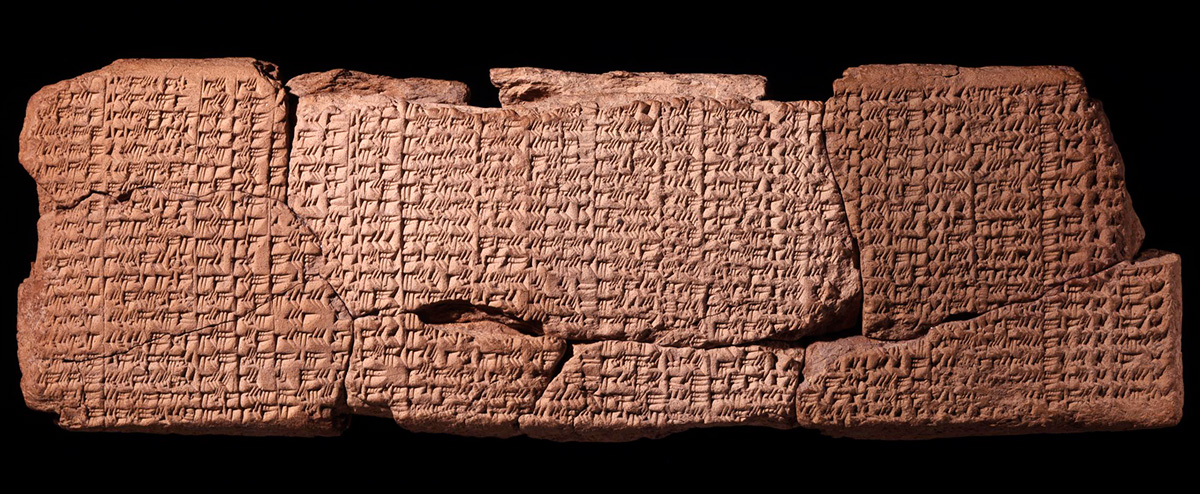Babylonian Lunar Systems

- Lunar synodic table.
- British Museum ME 34580.
- Image © the Trustees of the British Museum.
This cuneiform tablet contains calculated data for new moons for the years 280 to 210 of the Seleucid Era (104/103–102/101 BCE). The tablet was written by the son of a man named Nabu-balāṭsu-iqbī (unfortunately, the scribe’s own name is lost due to damage on the tablet) in the city of Babylon.
During the last four centuries BCE Babylonian astronomers developed advanced systems of mathematical astronomy for calculating lunar and planetary phenomena. In contrast to the geometrical models developed by Greek astronomy, these Babylonian systems used arithmetical sequences to model continuously varying astronomical functions needed to compute certain lunar and planetary phenomena. The lunar systems were the most complex and ambitious. Two primary systems are known, called System A and System B by modern scholars. These two systems have the same aim and basic structure but use different arithmetical functions in their computations.
The aim of a lunar synodic table is to compute the moon’s celestial longitude, the time of the conjunction or opposition, whether or not the moon or sun will be eclipsed, and the visibility of the moon for successive conjunctions or oppositions of the sun and moon. Astronomically, these are very complicated to model because they depend upon the varying speeds of the sun and the moon, the latitudinal motion of the moon, and the angle of the ecliptic to the horizon. From observation we can only see the combined effect of these variations, but the Babylonians successfully developed a way of separating out the individual effects and modelling them independently of one another using relatively simple numerical functions, which could then be added together to give a final result which takes into account all of the variations.
This tablet contains data computed using lunar System B. It is set out in the form of a table. Each row of the table concerns an individual new moon. The columns contain the values of numerical functions used in the calculation. In most cases, the value of a function is computed from the value in the previous row. For example, following a now lost column at the left which would have contained the date, the first preserved column contains the displacement of the moon through the zodiac (modulo 360 degrees) between the previous and the current new moon. The second column contains the moon’s longitude computed by adding the value in the second column to the moon’s longitude given in the previous row. A few columns contain the result of adding two or more columns together. For example, the tenth column contains the sum of the values in the seventh column, which models the contribution of lunar anomaly to the length of the month, and the ninth column, which models the contribution of solar anomaly, to give a final value for the length of the month. This value was then used to compute the time of conjunction by adding it to the time of the previous conjunction given in the row above.
Many of the complex, and often quite accurate, Babylonian systems of mathematical astronomy were widely known in the Greek world. For example, a few Greek papyri are known which contain data computed using the same lunar System B as this tablet. Greek astronomers such as Hipparchus, and Ptolemy used parameters taken from lunar System B and Geminus described the System B numerical function for lunar velocity.
Select Bibliography
- Jones, Alexander, 2002, “Babylonian Lunar Theory in Roman Egypt: Two New Texts”, in Under One Sky: Astronomy and Mathematics in the Ancient Near East, edited by Steele, John M. and Imhausen, Annette. Alter Orient und Altes Testament. Bd. 297. Münster: Ugarit-Verlag: 167–174.
- Neugebauer, Otto. 1955. Astronomical Cuneiform Texts, London: Lund Humphries: no. 122.
- Steele, John M. 2010. “Newly Identified Lunar and Planetary Tables from Babylon in the British Museum”, SCIAMVS 11: 211–239, text G.